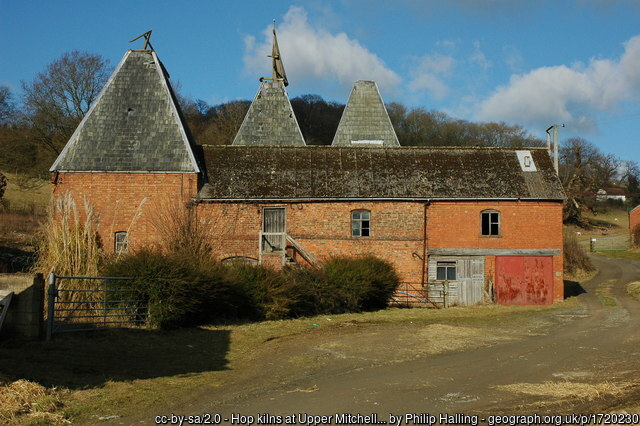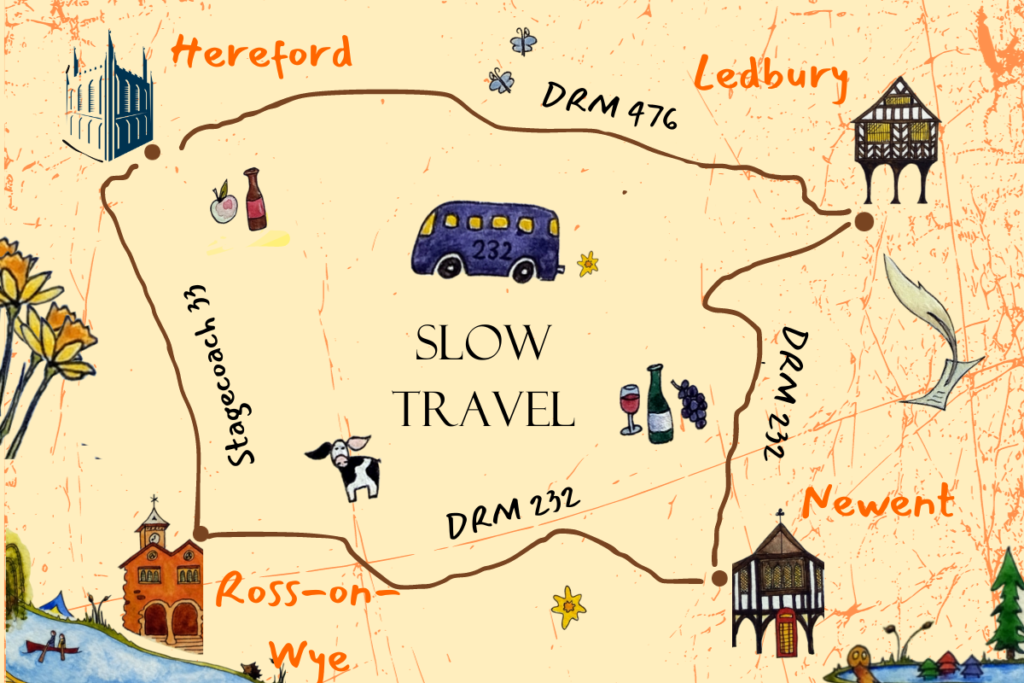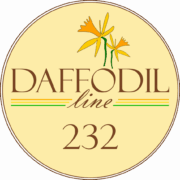Slow Travel gurus explain that exploring places should be relaxed and meaningful rather than rushing around by car. That could be by bicycle, walking, or even canoeing down a river, but in my book the bus is top of the list. Ok, it moves faster, but you are high up so you can see much more and still get a feeling about places through which you pass. Nothing better than peeping over hedgerows or into people’s gardens, clocking unusual buildings in villages and towns and admiring those rolling landscapes which reach to the sky. That’s slow travel at its best.
So, join me on a circular journey between the city of Hereford, Ledbury, Newent and Ross-on-Wye. You get to choose where to start your journey, it can be anywhere on the circular route. You can also plan where to stop off for a break and with the £2 fare cap on each leg a day’s wandering will not break the bank. Here’s an outing that’s possible any day of the week using DRM and Stagecoach buses.
Start at St Peter’s Square, Hereford; catch the 1015 476 DRM bus to Ledbury. I call this the ‘Hopline’ as you’ll see several hop yards, identified by tall poles which support the plants as they grow through the summer months. You might also see the conical shape of the old hop kilns alongside nearby farms. In reality the 476 passes by more orchards, rich in wildlife and packed with character at any time of the year.
Out of the city the bus descends through the Lugg meadows into Lugwardine and Bartestree where you’ll see the wooded limestone rim of the Woolhope Dome to the right. You’ll also catch a first glimpse of the majestic Malvern Hills, formed of ancient volcanic rocks. It is hard to believe that they date from 670 million years ago.

The bus soon passes through Stoke Edith where you might spot a delightful old red brick lodge on the right; it has a distinctive dome roof and chimney, and at one time was a gateway to Stoke Edith House which was sadly demolished in the 1950s. Tarrington next, with its range of Grade II listed buildings including the Tarrington Arms, and from here the bus winds its way to the Trumpet Inn, a 15th century half-timbered coaching house. The name refers to a time when stagecoaches sounded a horn on arrival at the crossroads. On the last stretch into Ledbury look out for the magnificent railway viaduct dating from 1860 and made of bricks handcrafted from local clay. You’ll also pass under a railway bridge which carried the old Daffodil rail line to Newent and Gloucester.
Alight in Ledbury at the 17th century Market House, built on 16 mighty oak pillars as a corn store. This is also the stop for the 232 Daffodil Line DRM bus for Newent and Ross. The Daffodil Line refers to an old nickname for the railway which carried millions of daffodils to urban markets every spring.
Across the road is the tall Gothic tower of the Barrett Browning Institute described by Pevsner, the architectural historian, as really terrible! Also on the right is St Katherine’s hospital and alms houses dating from the 13th century, but the buildings seen today are mainly from the 19th century. There are many distinctive houses on the route out of Ledbury, but none as grand as the half-timbered Ledbury Park house dating from the early 1600s; it is just beyond the traffic lights on the left in Southend. The first village of note is Much Marcle where the bus turns left by the Walwyn Arms, named after a 14th century local dignitary who lived at Hellens Manor, not easily seen from the bus. The bus runs through a pastoral landscape to Dymock, home to a group of famous poets, the likes of Rupert Brooke and Edward Thomas, from the time of the First World War; there’s a permanent exhibition to them in the church of St Marys.
Newent is the next major stopping place where you can alight to visit the old town centre noted for its mediaeval architecture or take a walk around the lake; there are several places for refreshment. The bus turns here for a journey westward through an undulating wooded landscape, colourful at this time of year as the leaves fall. There have been an increasing number of fruit orchards planted around Kilcot and through to the scattered village of Gorsley. From time to time there are views to the left across to the well known landmark May Hill, adorned by a group of pine trees planted in 1887 in recognition of Queen Victoria’s fifth decade on the throne.

The Daffodil Line bus terminates in Cantilupe Road; the next stand is for the 33 Stagecoach bus to Hereford. Ross is a thriving market town which like Ledbury and Newent has a half-timbered market house, but the bus skirts the centre to descend on the old turnpike road below the sandstone cliffs, the Royal Hotel and an ornate tower. It crosses the River Wye at Wilton bridge; look out for the 18th-century sundial on the left, and you might also catch a glimpse on the right of the ruins of a Norman castle.
The bus eases up at Peterstow common and to the right stands the orchards which produce the fruit for the Ross-on-Wye Cider and Perry company, located at the Yew Tree in the village. Harewood End marks the beginning of soft fruit production through to Much Birch where the bus leaves the main road to climb to King’s Thorn. Be sure to sit on the left hand side of the bus for the best views across to the Garway Hills, the Skirrid and the Sugar Loaf mountains. There are also amazing views over to the Black Mountains, as well as the Stockley and Merbach ridge and beyond to the Radnor Forest.
The 33 then passes through richer arable land before reaching Hereford, but still with views to the right of Aconbury and Dinedor hills, both of which have Iron Age Camps. As the travel pundits say, the journey is the thing.

Buses and Fares
For this slow travel itinerary you will use:
DRM Bus 476 between Hereford and Ledbury
DRM Bus 232 between Ledbury, Newent and Ross-on-Wye
Stagecoach bus 33 between Ross-on-Wye and Hereford
Services on all three routes run 7 days a week. Full details of all timings for planning your journey, starting at any point along the route, can be found at bustimes.org. You can also use bustimes.org to track all of the buses, live, on your day of travel.
The £2 single is available on all three routes. DRM also offer a day rider which is valid on the 232 and the 476. This is £6 Monday to Saturday and £3 on Sundays. This ticket is not valid on the 33 but may still work out good value for you, if you are planning lots of stops.
Happy travels!



Excellent article!
I presume with this tour of Herefordshire one has to first catch a Stagecoach bus into Hereford from Ross-on-Wye?
thats right, or go the other way and head first to Newent and Ledbury, coming home via Hereford.
Just to thank all involved for the daffodil bus service.a tremendous achievement made even better by the regular updating of now teachable by bus places and events.all building community by more sustainable travel.big thanks to you all.go well in every way in 2024!
Thank you for your kind words!